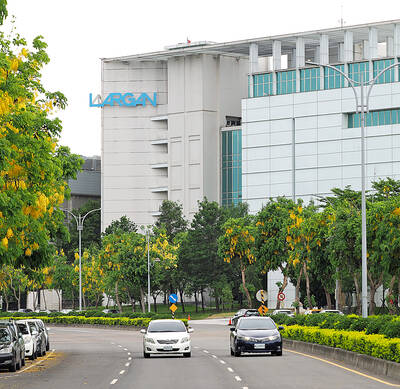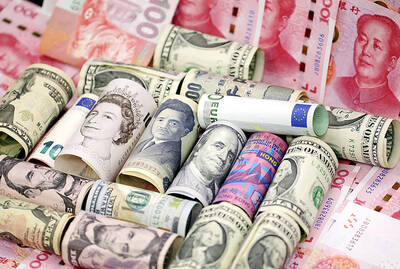Sony Corp shares yesterday fell the most in almost two years after the electronics maker missed profit estimates and forecast weaker sales and operating profits across most of its business units.
The stock fell 6.1 percent to ¥5,073 in Tokyo, the biggest one-day drop since June 2016 and the first trading session after last week’s earnings.
The move wiped out about US$4 billion from the company’s market value, while volume doubled the 180-day average.
Sales in Sony’s mobile, PlayStation, music, movies and home entertainment divisions are forecast to decline in the year to March next year, the Tokyo-based company said in a statement on Friday last week.
Only cameras, chips and financial services were seen improving slightly.
According to the outlook, operating profit is to decline to ¥670 billion (US$6.1 billion), less than analysts’ prediction for ¥747 billion.
Analysts expressed concerned over Sony’s weak outlook for smartphone camera chips, where it forecast a 39 percent decline in operating profit.
JPMorgan Chase & Co analyst J.J. Park lowered the firm’s price target for Sony from ¥5,400 to ¥5,200, telling investors to stay on the sidelines until shares finish adjusting to the weaker demand for smartphones.
“We expect Sony’s share price to follow the performance in Apple [Inc] supply chain names, which have shown a meaningful correction,” Park, Ky Oh and Hisashi Moriyama wrote in a note to clients on Saturday, in which they maintained their neutral rating on the stock. “We recommend that investors find a better entry point after a share price correction.”
Yesterday’s decline brought the gap between analyst price targets and the actual price to the widest since March 2016, data compiled by Bloomberg showed.
Sony CEO Kenichiro Yoshida needs to boost revenue by coming up with new products and services after five years of restructuring that he pushed through as chief financial officer with his predecessor, Kazuo Hirai.
While the changes have left Sony on solid footing, the company remains vulnerable to any potential downturn given that it is the top supplier for image sensors that go into the devices, including Apple’s iPhone.
Total operating profit was a record ¥735 billion for the year through March. Analysts were projecting an average of ¥743 billion.
Full-year sales rose 12 percent to ¥8.54 trillion.
“We’ve delivered on the promises we laid out and reached ¥500 billion profits in back-to-back years,” Sony chief financial officer Hiroki Totoki said at a news conference after the results. “Given we’ve never before achieved that, that accomplishment weighs very heavily on our shoulders, but that’s why it’s very important to continue to properly earn stable profits.”
SMARTPHONE WOES
Cooling demand for smartphones across markets is hitting Sony on two fronts: less demand for mobile camera chips and poor demand for Sony’s own models.
The Xperia division recorded a write-down and forecast an operating loss of ¥15 billion in the coming year.
The semiconductor unit would post a 39 percent decline in operating profit, Sony said, even though sales are seen climbing slightly.
“It’s not a great time for smartphones,” Asymmetric Advisors senior strategist Amir Anvarzadeh said in Singapore. “Sony has had phenomenal growth in the past few years, so it doesn’t take a genius to see that it will be harder to maintain from here on.”
Still, many investors remain optimistic, with Sony shares near 10-year highs.
A Bloomberg analysis of share price data suggested that chief financial officers turned CEOs tend to perform well.
In the 28 instances since the mid-1990s when large nonfinancial corporations promoted their finance chiefs to the top job, the stocks on average did twice as well as the broader market.
Sony shares were up about 6 percent before the results, following a 55 percent rally last year.
“Yoshida-san understands the stock market very well,” Bloomberg Intelligence analyst Masahiro Wakasugi said. “Expectations are as high as ever, but he’s the type who can probably respond to what the market wants.”
Operating profit at the chip unit was ¥164 billion in the latest fiscal year, better than Sony’s own estimate for ¥155 billion.
For the coming year, the company forecast a decline to ¥100 billion.
Sony said it was stepping up capital expenditure in the unit to ¥160 billion, of which ¥130 billion would be for image sensors.
Apple suppliers, including Sony, have been hit by poor demand for the iPhone X. However, with some Chinese smartphone manufacturers, such as Huawei Technologies Co (華為), now outfitting models with three rear-facing cameras, demand for image sensors might hold up.
Full-year operating profit in the gaming division was ¥177.5 billion, missing Sony’s estimate for ¥180 billion. The company sold 19 million PlayStation 4s, matching its forecast.
In the coming year, it expects to generate ¥190 billion in operating profit, while PlayStation 4 sales would slow to 16 million.
The film unit had an operating profit of ¥41.1 billion on sales of ¥1.01 trillion, compared with Sony’s estimate for ¥39 billion and ¥1.02 trillion respectively.
The company sees operating profit remaining mostly flat at ¥42 billion, with revenue shrinking to ¥960 billion.
Sony had one of its strongest box office performances in years, announcing this month that the new Jumanji movie had become its highest-grossing film in history.

Handset camera lens maker Largan Precision Co (大立光) on Sunday reported a 6.71 percent year-on-year decline in revenue for the third quarter, despite revenue last month hitting the highest level in 11 months. Third-quarter revenue was NT$17.68 billion (US$581.2 million), compared with NT$18.95 billion a year earlier, the company said in a statement. The figure was in line with Yuanta Securities Investment Consulting Co’s (元大投顧) forecast of NT$17.9 billion, but missed the market consensus estimate of NT$18.97 billion. The third-quarter revenue was a 51.44 percent increase from NT$11.67 billion in the second quarter, as the quarter is usually the peak

Taiwan’s foreign exchange reserves hit a record high at the end of last month, surpassing the US$600 billion mark for the first time, the central bank said yesterday. Last month, the country’s foreign exchange reserves rose US$5.51 billion from a month earlier to reach US$602.94 billion due to an increase in returns from the central bank’s portfolio management, the movement of other foreign currencies in the portfolio against the US dollar and the bank’s efforts to smooth the volatility of the New Taiwan dollar. Department of Foreign Exchange Director-General Eugene Tsai (蔡炯民)said a rate cut cycle launched by the US Federal Reserve

The US government on Wednesday sanctioned more than two dozen companies in China, Turkey and the United Arab Emirates, including offshoots of a US chip firm, accusing the businesses of providing illicit support to Iran’s military or proxies. The US Department of Commerce included two subsidiaries of US-based chip distributor Arrow Electronics Inc (艾睿電子) on its so-called entity list published on the federal register for facilitating purchases by Iran’s proxies of US tech. Arrow spokesman John Hourigan said that the subsidiaries have been operating in full compliance with US export control regulations and his company is discussing with the US Bureau of

Pegatron Corp (和碩), a key assembler of Apple Inc’s iPhones, on Thursday reported a 12.3 percent year-on-year decline in revenue for last quarter to NT$257.86 billion (US$8.44 billion), but it expects revenue to improve in the second half on traditional holiday demand. The fourth quarter is usually the peak season for its communications products, a company official said on condition of anonymity. As Apple released its new iPhone 17 series early last month, sales in the communications segment rose sequentially last month, the official said. Shipments to Apple have been stable and in line with earlier expectations, they said. Pegatron shipped 2.4 million notebook